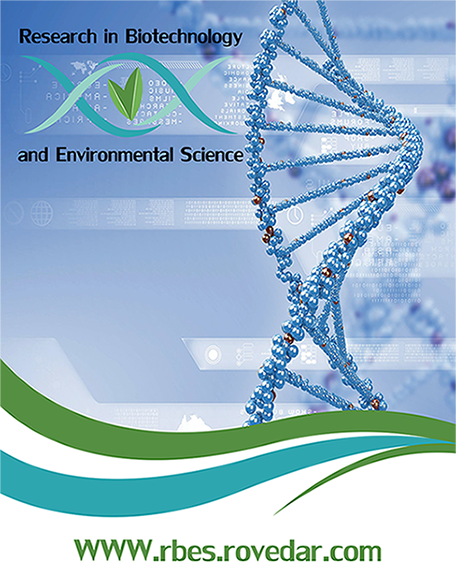Comparing the Effects of Diesel Oil Pollution on Forest and Industrial Soil Microbial Community
Main Article Content
Abstract
Introduction: Diesel oil is the most used petroleum product in Iran and other countries. The majority of diesel oil is stored in underground reservoirs and Fuel stations. This product can heavily pollute the adjacent soil. Diesel oil pollution has some ecological effects on soil that disturb the composition and diversity of the microbial community. The present research aimed to investigate the effects of diesel oil pollution on two different types of soil.
Materials and Methods: To examine the effects of diesel oil on microbial communities, two different types of soil (industrial and forest types) were collected from Kerman province, Iran. Six microcosms were designed based on three microcosms existing in each type of soil, including unpolluted microcosm, polluted microcosm, and polluted microcosm with nutrients (Nitrogen and Phosphor). Some factors were assayed in each microcosm during 120 days of the experiment. These factors included total heterotrophic bacteria, total diesel oil-degrading bacteria, dehydrogenase enzyme, and diesel oil biodegradation.
Results: The quantity of diesel oil-degrading bacteria was significantly lower than heterotrophic bacteria in all soil microcosms. The quantity of diesel oil-degrading bacteria had a decrement pattern until day 60 of the experiment, but after that, these bacteria had an increment pattern. The best dehydrogenase activity between different microcosms was related to polluting microcosms with diesel oil except for farmland soil. The highest biodegradation of diesel oil in all studied soil types belonged to the industrial microcosm (95%). Statistical analysis of the results indicated a significant correlation between the most probable number quantity of heterotrophic bacteria and other assayed factors. Forest soil was significantly different from other soil types.
Conclusion: Given the obtained results of the current research, that forest soil is more sensitive to diesel oil pollution, compared to industrial soil. It is, therefore, possible to propose appropriate strategies for the bioremediation of different studied soil types.
Article Details

This work is licensed under a Creative Commons Attribution 4.0 International License.
Funding data
References
Zanaroli G, Toro SD, Todaro D, Varese GC, Bertolotto A, and Fava F. Characterization of two diesel fuel degrading microbial consortia enriched from a non acclimated, complex source of microorganisms. Microb Cell Factories. 2010; 9: 10. Available at: https://link.springer.com/article/10.1186/1475-2859-9-10
Lee M, Kim MK, Singleton I, Goodfellow M, Lee S-T. Enhanced biodegradation of diesel oil by a newly identified Rhodococcus baikonurensis EN3 in the presence of mycolic acid. J Appl Microbiol, 100(2): 325-333. DOI: https://doi.org/10.1111/j.1365-2672.2005.02756.x
Gianfreda L, Antonietta M, Piotrowska A, palumbo G, and Colombo C. Soil enzyme activities as affected by anthrogenic alterations: intensive agricultural practice and organic pollution. Scien Total Environ.
; 341(1-3): 265-279. DOI: https://doi.org/10.1016/ j.scitotenv.2004.10.005
Hong JH, Kim J, Choi OK, Cho KS, and Ryu HW. Characterization of a diesel degrading bacterium, Pseudomonas aeruginosa IU5, isolated from oil-contaminated soil in Korea. World J Microbiol Biotechnol. 2005; 21: 381-384. Doi: 10.1007/s11274-004-3630-1
Hess B, Bekker H, Berendsen HJC, Fraaije JGEM, and J Comp. LINCS: A linear constraint solver for molecular simulations. Chem. 1997;
: 1463-1472. Available at: https://www.cs.rug.nl/~bekker/ publications/lincs.pdf Mukherji S and Vijay A. Critical issues in bioremediation of oil and tar contaminated sites. In: Proceedings of the international conference on advances in civil engineering, Civil Eng Dept., IIT Kharagpur, India, 3-5 January 2002, pp. 507-516.
Alef K and Nanniper P. Methods in applied soil microbiology and biochemistry, New York: Academic Press; 1995.p. 228. Available at: https://www.elsevier.com/books/methods-in-applied-soil-microbiology-and-biochemistry/alef/978-0-12-513840-6
Ives AR, Foufopoulos J, Klopfer ED, Klug JL, and Palmer TM. Bottle or big-scale studies: How do we do ecology. Ecol. 1996; 77(3): 681-685. Available at: https://digitalcommons.fairfield.edu/cgi/viewcontent. cgi?article=1043&context=biology-facultypubs
Cappello S, Denaro R, Genovese M, Giuliano L, and Yakimov MM. Predominant growth of Alcanivorax during experiments on oil spill bioremediation in mesocosms. Microbiol Res. 2006; 162(2): 185- 190. DOI: https://doi.org/10.1016/j.micres.2006.05.010
Robertson S, Rutherford PM, and Massicotte HB. Plant and soil properties determine microbial community structure of shared Pinus-Vaccinium rhizospheres in petroleum hydrocarbon contaminated forest soil. Plant and Soil. 2011; 346: 121. Available at: 10.1007/s11104-011-0802-2
Brown EJ and Braddock JF. Sheen screen, a miniaturized Most-Probable Number method for enumeration of oil-degrading microorganisms. Appl Environ Microbiol. 1990; 56(12): 3895-3896. DOI: https://doi.org/10.1128%2Faem.56.12.3895-3896.1990
Wrenn BA and Venosa AD. Selective enumeration of aromatic and aliphatic hydrocarbon degrading bacteria by a most probable number procedure. Cana J Microbiol. 1996; 42(3): 252-258. DOI: https://doi.org/10.1139/m96-037
Rahman KSM, Thahira-Rahman J, Lakshmanaperumalsamy P, and Banat IM. Towards efficient crude oil degradation by a mixed bacterial consortium. Biores Technol. 2004; 85: 257-261. DOI: https://doi.org/10.1016/s0960-8524(02)00119-0
Hassanshahian M. Isolation and characterization of biosubiosurfactant-producingeria from Persian Gulf (Bushehr provenance). Mar Pollut Bull. 2014; 86(1-2): 361-366. DOI: https://doi.org/10.1016/j.marpolbul.2014.06.043
Barathi S and Vasudevan N. Utilization of petroleum hydrocarbons by Pseudomonas fluorescens isolated from petroleum contaminated soil. Environ Int. 2001; 26(5-6): 413-416. DOI: https://doi.org/10.1016/s0160-4120(01)00021-6
Del Arco JP and De Franca FP. Influence of oil contamination levels on hydrocarbon biodegradation in sandy sediment. Environ Pollut. 2001; 112(3): 515-519. DOI: https://doi.org/10.1016/s0269-7491(00)00128-7
Delille D and Coulon F. Comparative mesocosm study of biostimulation efficiency in two different oil-amended sub-Antarctic soils. Microb Ecol. 2008; 56: 243-252. DOI: https://doi.org/10.1007/s00248-007-9341-z
Li H, Zhang Y, Kravchenko I, Xu H, and Zhang Cg. Dynamic changes in microbial activity and community structure during biodegradation of petroleum compounds: A laboratory experiment. J Envi Sci. 2007; 19: 1003-1013. DOI: https://doi.org/10.1016/s1001-0742(07)60163-6
Ojimba T. Determining the effects of crude oil pollution on crop production using stochastic trans log production function in Rivers State, Nigeria. J Develop Agri Eco. 2012; 4(13): 346-360. Avaialble at: https://academicjournals.org/journal/JDAE/article-full-text-pdf/42C8E8D1427
Radwan SS, Al-Hasan RH, Ali N, Salamah A, and Khanafer M. Oil-consuming microbial consortia floating in the Arabian Gulf. Int Biodeterio Biodegradation. 2005; 56(1): 28-33. Available at: https://inis.iaea.org/search/search.aspx?orig_q=RN:37002947
Amadi A, Samuel D, and Anthony N. Chronic effects of oil spill on soil properties and microflora of a rainforest ecosystem in Nigeria. Wat Air and Soil Poll. 1996; 86: 1-11. Doi: 10.1007/BF00279142
Riffaldi R, Levi-minzi R, Cardelli R, Palumbo S, and Saviozzi A. Soil biological activities in monitoring the bioremediation of diesel oil-contaminated soil, Wat Air and Soil Poll, 2006; 170: 3-15. Doi: 10.1007/s11270-006-6328-1


